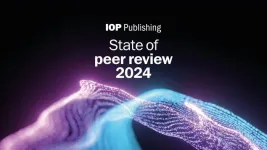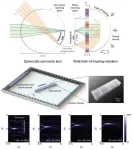(Press-News.org) More than 20,000 volunteers have been recruited to a resource aimed at speeding up the development of much-needed dementia drugs. The cohort will enable scientists in universities and industry to involve healthy individuals who may be at increased risk of dementia in clinical trials to test whether new drugs can slow the decline in various brain functions including memory and delay the onset of dementia.
Using the resource, scientists have already been able to show for the first time that two important bodily mechanisms – inflammation and metabolism – play a role in the decline in brain function as we age.
By 2050, approximately 139 million people are expected to be living with dementia worldwide. In the UK, in 2022, UK Prime Minister launched the Dame Barbara Windsor Dementia Mission, part of the government’s commitment to double increase research funding for dementia.
Although there has been recent progress developing drugs that slow down progression of the disease, the two leading treatments only have a small effect, and the vast majority of new approaches that work in animal studies fail when it comes to patient clinical trials.
One explanation for these failures is that the drugs are tested in people who already have memory loss – and by this point, it may be too late to stop or reverse the disease. Hence, there is an urgent need to understand what is going on before people develop symptoms at the very early stages of disease, and to test new treatments before people come to their doctor with cognitive problems. This approach requires a large cohort of participants willing to be recalled for clinical and experimental studies of cognitive decline.
Today, writing in the journal Nature Medicine, scientists led by the University of Cambridge in partnership with the Alzheimer’s Society report how they have recruited 21,000 people aged 17-85 to the Genes and Cognition Cohort within the National Institute for Health and Care Research (NIHR) BioResource.
The NIHR BioResource was established in 2007 to recruit volunteers keen to engage in experimental medicine and clinical trials across the whole of medicine. Approximately half of its participants are recruited to disease specific cohorts, but the other half are from the general public, and detailed information about their genetics and their physical makeup has been collected. They have all given their consent to be contacted about future research studies.
For the Genes and Cognition Cohort, researchers used a combination of cognitive tests and genetic data, combined with other health data and demographic information, to enable the first at-scale study of cognitive changes. This will allow the team to recruit participants for studies of cognitive decline and new treatments for this.
For example, a pharmaceutical company with a promising new drug candidate to slow the cognitive decline could recruit people through the BioResource based on their profile and invite them to join in the clinical trial. Having a baseline measurement for their cognitive performance will allow scientists to observe whether the drug slows their expected cognitive decline.
Professor Patrick Chinnery from the Department of Clinical Neurosciences at the University of Cambridge and co-Chair of the NIHR BioResource, who has led the project, said: “We’ve created a resource that is unmatched anywhere else in the world, recruiting people who are not showing any signs of dementia rather than people already having symptoms. It will allow us to match individuals to particular studies and speed up the development of much-needed new drugs to treat dementia.
“We know that over time our cognitive function decreases, so we’ve plotted out the expected trajectory of various different cognitive functions over our volunteers’ life course according to their genetic risk. We’ve also asked the question, ‘What are the genetic mechanisms that predispose you to slow or fast cognitive decline as you age?’.”
Using the research, the team have identified two mechanisms that appear to affect cognition as we age and could serve as potential targets to slow down cognitive decline and thereby delay the onset of dementia. The first of these is inflammation, with immune cells specific to the brain and central nervous system – known as microglia – causing gradual deterioration of the brain and hence its ability to perform key cognitive functions. The second mechanism relates to metabolism – in particular, how carbohydrates are broken down in the brain to release energy.
Professor Chinnery added: “Cognitive decline is a natural process, but when it drops below a particular threshold, that’s when there’s a problem – that is when we would diagnose dementia. Anything that slows that decline will delay when we drop below that threshold. If you could put off the onset of dementia from 65 to 75 or even 85, it would make a huge difference at an individual and at a population level.”
Dr Richard Oakley, Associate Director of Research and Innovation at Alzheimer’s Society, said: “This exciting study, funded by Alzheimer’s Society, is an important step in helping us to better understand how the diseases that cause dementia begin, and will aid in the development of new treatments that target the early stages of these diseases.
“The data, from over 20,000 volunteers, helps us to better understand the connection between participants’ genes and cognitive decline and allows for further ground-breaking analysis in future.
“One in three people born in the UK today will go on to develop dementia in their lifetime but research will beat dementia. We need to make it a reality sooner through more funding, partnership working and people taking part in dementia research.”
For further information about how you can join the BioResource and contribute to studies like this one and many others, please visit www.bioresource.nihr.ac.uk.
The research was supported by the Alzheimer’s Society and the NIHR BioResource. The researchers were also supported by Wellcome and the Medical Research Council.
Reference
Rahman, MS et al. Dynamics of cognitive variability with age and its genetic underpinning in NIHR BioResource Genes and Cognition Cohort participants. Nat Med; 14 May 2024; DOI: 10.1038/s41591-024-02960-5
END
Over 20,000 people join search for new dementia treatments
2024-05-14
ELSE PRESS RELEASES FROM THIS DATE:
Artificial intelligence tool detects sex-related differences in brain structure
2024-05-14
Artificial intelligence (AI) computer programs that process MRI results show differences in how the brains of men and women are organized at a cellular level, a new study shows. These variations were spotted in white matter, tissue primarily located in the human brain’s innermost layer, which fosters communication between regions.
Men and women are known to experience multiple sclerosis, autism spectrum disorder, migraines, and other brain issues at different rates and with varying symptoms. A detailed understanding of how ...
A bionanomachine for green chemistry
2024-05-14
Researchers at the Paul Scherrer Institute PSI have for the first time precisely characterised the enzyme styrene oxide isomerase, which can be used to produce valuable chemicals and drug precursors in an environmentally friendly manner. The study appears today in the journal Nature Chemistry.
Enzymes are powerful biomolecules that can be used to produce many substances at ambient conditions. They enable “green” chemistry, which reduces environmental pollution resulting from processes used in synthetic chemistry. One such tool from nature has now been characterised in detail by ...
How wildfires change soil chemistry
2024-05-14
The huge, long-lasting wildfires that have become increasingly common in recent years can cause changes in soil chemistry that affect water contamination, air quality, and plant growth. But these changes are poorly monitored and rarely factor into post-fire recovery efforts or risk assessments, according to a review study published May 14 in Nature Reviews Earth & Environment.
The study, led by Stanford University and Colorado State University scientists, found that better techniques are needed to monitor changes in soil and surrounding ecosystems. This enhanced ...
Genes driving age-related blood cell mutations uncovered
2024-05-14
Scientists have discovered 17 additional genes that drive the abnormal overgrowth of mutated blood cells as we age. The findings, published today (14 May) in Nature Genetics, provide a more complete view of the genetic factors behind clonal haematopoiesis – a process associated with ageing and linked to increased risks of blood cancers1.
Researchers from the Wellcome Sanger Institute, Calico Life Sciences, California, and the University of Cambridge analysed sequencing data from over 200,000 individuals in the UK Biobank cohort. They searched for genes showing signals of "positive selection" – where mutations ...
WASP-193b, a giant planet with a density similar to that of cotton candy
2024-05-14
An international team led by researchers from the EXOTIC Laboratory of the University of Liège, in collaboration with MIT and the Astrophysics Institute in Andalusia, has just discovered WASP-193b, an extraordinarily low-density giant planet orbiting a distant Sun-like star.
This new planet, located 1,200 light-years from Earth, is 50% larger than Jupiter but seven times less massive, giving it an extremely low density comparable to that of cotton candy. "WASP-193b is the second least dense planet discovered to date, after Kepler-51d, which is much smaller," explains ...
IOP Publishing report reveals peer review capacity not used to its full potential
2024-05-14
A new global study from IOP Publishing (IOPP) has found that certain peer review communities continue to feel overburdened by reviewer requests, while others remain underrepresented.
The survey, which generated over 3,000 responses from peer reviewers from across the globe, revealed regional and career-stage disparities:
30% of reviewers from high-income countries indicated that they receive too many peer review requests, compared with just 10% from low and middle-income countries*
Just 6% of respondents from China and 7% from India indicated that they ...
Eco-friendly and affordable battery for low-income countries
2024-05-14
A battery made from zinc and lignin that can be used over 8000 times. This has been developed by researchers at Linköping University, Sweden, with a vision to provide a cheap and sustainable battery solution for countries where access to electricity is limited. The study has been published in the journal Energy & Environmental Materials.
“Solar panels have become relatively inexpensive, and many people in low-income countries have adopted them. However, near the equator, the sun sets at around 6 PM, leaving households and businesses without electricity. The hope is that ...
New transit station in Japan significantly reduced cumulative health expenditures
2024-05-14
The declining population in Osaka is related to an aging society that is driving up health expenditures. Dr. Haruka Kato, a junior associate professor at Osaka Metropolitan University, teamed up with the Future Co-creation Laboratory at Japan System Techniques Co., Ltd. to conduct natural experiments on how a new train station might impact healthcare expenditures.
JR-Sojiji Station opened in March 2018 in a suburban city on the West Japan Railway line connecting Osaka and Kyoto. The researchers used a causal impact algorithm to analyze the medical expenditure data gathered from the time series medical ...
USC study reveals racial disparities in diagnosis and drug use for dementia symptoms
2024-05-14
Compared to Black and Asian people, white and Hispanic people with Alzheimer’s disease and related dementias were most likely to be diagnosed with symptoms like depression and agitation, according to a new study from the USC Schaeffer Center for Health Policy & Economics.
White and Hispanic people with these diagnoses were also most likely to be prescribed central nervous system (CNS) active drugs, including antidepressants, antipsychotics and anticonvulsants. Yet, these drugs have been associated with higher risk of falls, cardiovascular events, hospitalization and death, according to the study published today in the Journal of Alzheimer’s ...
Metalens expands Its reach from light to sound
2024-05-14
Junsuk Rho from the Department of Mechanical Engineering, the Department of Chemical Engineering, and the Department of Electrical Engineering, Dr. Dongwoo Lee from the Department of Mechanical Engineering, and Beomseok Oh, a PhD student, from the Department of Chemical Engineering at Pohang University of Science and Technology (POSTECH) have achieved a breakthrough in surpassing the limitations of traditional acoustic metalenses. They have successfully developed the first wide field-of-hearing metalens. This research has been recently published in the international journal, Nature Communications.
Sound ...




